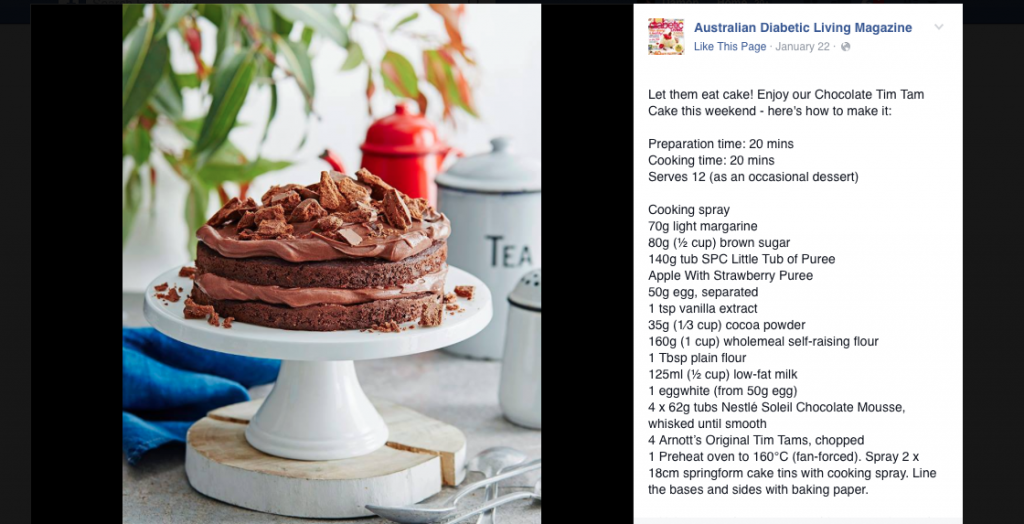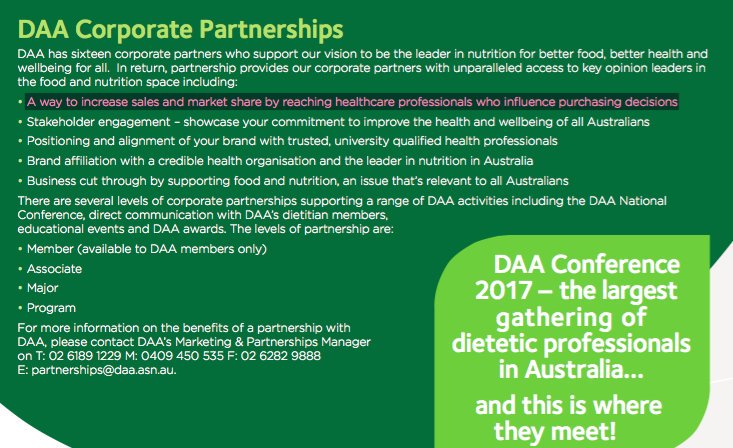Just four tubs of Nestle Soleil Chocolate Mousse, whisked until smooth, and four Arnott’s Original Tim Tams, some cocoa powder, brown sugar and a few other goodies, and presto!
“Let them eat cake!” declares Australian Diabetic Living Magazine. It’s a good thing that half a cup of milk in the recipe is low-fat milk or the Chocolate Tim Tam Cake featured below might cause high blood sugar levels.
This sort of thing from the food media and the diabetic education industry does little to quell the rising tide of critics who charge that industry is recklessly pushing sugar to the benefit of drug giants who make billions of dollar selling insulin. Diabetes is big business. According to Reuters, the number of people living with diabetes has tripled since 2000, pushing the global cost of the disease to $850 billion a year.
With this sort of money at stake, an investigation into the ties between the medical profession, Big Pharma, the packaged food giants and the diabetes lobby is overdue.
This story makes no judgement on medical issues. Many believe the answer to the Type 2 diabetes epidemic – which, as opposed to Type 1 diabetes, is linked to obesity and lack of exercise – rests with diet, cutting out sugar and carbohydrates (glucose) that is, rather than advising patients to eat carbs and then use medication to deal with the increased blood glucose levels.
The publication of this opinion piece a few days ago set off a firestorm on Twitter. Many rejected the article, saying it was irresponsible to ignore conventional medical advice. Many others argued just as heatedly that the claims were correct.
And so, emphasising again this writer has no expertise in medicine and does not espouse any medical view here, let’s examine the conflicts of interest.
The peak body for diabetes in this country is Diabetes Australia. It’s revenues last year were $242 million and its corporate partners include drug giants Astra-Zeneca, Sanofi, Roche, Abbott, Aspen Medical, Bayer and Eli Lilly.
The peak body for diabetes educators is the Dieticians Association of Australia (DAA) which recorded revenues of $5 million last year and discloses The Australian Breakfast Cereal Manufacturers Forum (ABCMF), Arnott’s and Nestle among its corporate partners.
There are those names again: Arnott’s of Tim Tam fame and Nestle of Nestle Soleil Chocolate Mousse fame. Responding to questions for this story the DAA, said corporate sponsorships amounted to only eight per cent of income, the bulk of which comes from professional fees paid by dietician members.
The corporate influence however is clear. At an event earlier this year, the following pamphlet was in evidence:
Promoting corporate partnerships as a “way to increase sales and market share by reaching healthcare professionals who influence purchasing decisions”, “positioning and alignment of your brand with trusted, university qualified health professionals” and “brand affiliation with a credible health organisation and the leader in nutrition in Australia” would appear to be blatant conflicts of interest.
Should qualified health professionals be promoting Nestle and Arnott’s? The DAA’s relationship with Australian Breakfast Cereal Manufacturers Forum (ABCMF) is also questionable as this peak body represents Carman’s, Freedom, Kellogg, Nestlé and Sanitarium, all of whose products are high in sugar.
We list the DAA’s responses to questions at the bottom of this article.
Diabetes Australia was unable to respond to questions for the story by deadline. Should it respond, the answers will be appended later.
The reason the revenues of DA are so high – more than one billion dollars over the past five years – is that it is not merely an advocacy and professional body but administers the federal government’s National Diabetes Services Scheme (NDSS).
Again, making no claim as to the efficiency or professionalism of DA, one thing is certain, this is one of the most highly funded peak bodies in Australia; far more flush with funds than the oil and gas, resources, banking or property lobbies.
Income over the last four years was $223 million, $230 million, $240 million and $242 million with the lion’s share coming in government grants. Commercial Partnerships tipped in $1.1 million last year. Over four years Commercial Partnerships, Donations and Bequests and Fundraising accounted for $10 million in income.
At last balance date, DA was sitting on $17.7 million in cash. With a balance sheet like that, one wonders if all the relationships with Big Pharma are a necessary conflict of interest to have.
There are numerous insulin medications and device manufacturers in the market. The “Big Three” are Novo Nordisk, Eli Lilly and Sanofi, two of which are DA commercial partners. Roche makes insulin pumps, AstraZeneca makes SGLT-2 diabetes meds, Abbott makes glucose monitors, Lilly makes insulin injections. These are all DA commercial partners.
In 2016, long-acting insulin was the tenth most expensive drug for the federal government, costing $146 million for 367,253 scripts. Metformin, which controls blood sugar levels, is the seventh most prescribed drug.
What is not always considered are the other costs of complications arising from diabetes like amputations in hospital, and retinal and kidney diseases.
As the cost of the Pharmaceutical Benefits Scheme goes ballistic and the pharma giants continue to aggressively avoid paying income tax in Australia, it is time for extra scrutiny of the free ride the drug companies enjoy care of taxpayers in this country. Added to that, the infiltration of the Big Pharma and sugar lobbies into the DA and DAA peak bodies, and the explosion in diabetes suffers, now 451 million world-wide, and it is worth asking if more should be done to cure diabetes at the source, diet, rather than pushing sugar and insulin.
Excusez-nous: French giant Sanofi takes Australia to the cleaners
This investigation is part of a series of investigations into Australia’s peak bodies which has been funded by GetUp!
QUESTIONS FOR DIABETES AUSTRALIA
QUESTIONS FOR DAA
1. The DAA financial statements show in the Revenue note “membership fees”. Are these for corporations as well as individuals?
Membership fees relates to the number of financial members, as per the calendar year. Members of the Dietitians Association of Australia (DAA) include qualified dietitians (who have gained a recognised dietetics qualification through an accredited university program or have completed the dietetics skills recognition exam) or dietetics students enrolled in an entry level dietetics qualification in Australia. Dietitians living overseas and registered with a national dietetic association can also be affiliate members of DAA. Revenue from Corporate Partners and Sponsors are not included under ‘Membership fees’.
2. Does advertising, sponsorship, conference etc revenue come from DAA’s corporate partners?
Income for corporate partnerships is included under ‘Advertising and sponsorship’, along with advertising and sponsorship revenue from other companies. Corporate partnership revenue remains stable at 8% of total income across both 2016 and 2017. The largest contribution from a single corporate partner is 1.1% of total income. So, income from Corporate Partnerships makes up a small portion of DAA’s overall income. By limiting the amount of financial support we receive from our Corporate Partners, we ensure that none has enough financial leverage to compromise our independence.
3. Why are related party transactions – Note 15 – not individually disclosed? What are they?
No answer.
4. Does DAA have commercial (advertising sponsorship membership etc) relationships with The Australian Beverages Council or Diabetes Living Magazine?
DAA does not currently have a partnership with these companies. We provided comments for an article in Diabetic Living Magazine earlier this year, after they approached us in response to our media release on ‘budget friendly foods to help university results’.
5. Has DAA been involved with research into the effect of low carb diets on diabetes?
DAA is an organisation which operates to advance and promote nutrition and dietetics in Australia, as well as provide a regulatory function in university program accreditation and credentialing for Accredited Practising Dietitians. Many of our members undertake research in various health and nutrition related fields, however DAA as an organisation is not involved in clinical research.
6. Has DAA made representations to active or potential corporate sponsors and partners that partnership with DAA would be a way to increase sales because of the influence of dieticians?
Previous conference sponsorship prospectuses and communications with potential partners have included wording as such. Our current strategic plan aims to positively influence the food supply. We undertake a risk assessment process before entering into all agreements for sponsorship or partnership.
Our National Conference is an opportunity to inform our members of foods that are available in the commercial market, to increase their knowledge about the food products that their clients may be choosing, so APDs in turn can promote healthier options. We have robust processes in place to determine who can exhibit at our conference and what they can exhibit.
Working with Corporate Partners allows us to extend evidence-based nutrition messages further and improve the health of Australians more than we could do on our own. Importantly, we ensure that activities undertaken with each Corporate Partner are in line with our vision and mission, and relate to our profession. We have a number of protections in place to ensure that our Corporate Partners do not influence our decision making within DAA. These include binding legal contracts, robust and transparent policies and procedures and a risk assessment process before any partnership takes place.
Financial independence is paramount to DAA, and as illustrated in question 2, only a small portion of total income is provided by our corporate partners.
We maintain our transparency with our partnerships and information about these are publicly available via our Corporate partners and Alliances webpage.
Michael West established Michael West Media in 2016 to focus on journalism of high public interest, particularly the rising power of corporations over democracy. West was formerly a journalist and editor with Fairfax newspapers, a columnist for News Corp and even, once, a stockbroker.



